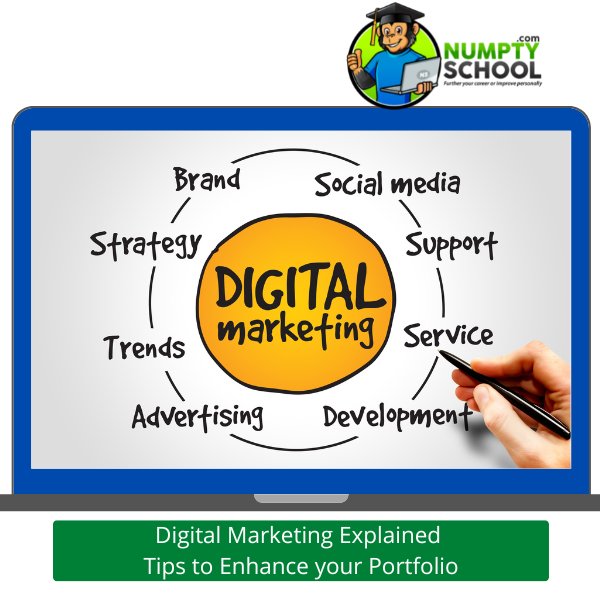Digital Marketing Explained Tips to Enhance your Portfolio

On the basic level, digital marketing is a form of advertising delivered via digital channels like websites, search engines, email, mobile applications and social media platforms.
Using the mentioned online channels, companies endorse services, products and brands through this form of advertising.
Research shows that consumers primarily rely on digital media to know about products, and about 48% begin their inquiries on various search engines.
33% depend on brand websites to get the information they need, and 26% browse mobile apps.
Today’s digital marketing is a vast system of effective channels that marketers need to onboard their businesses or brands.
Online advertising is more complex than the said channels.
To achieve the highest digital marketing potential, a marketer must dig deeper into today’s intricate and enormous cross-channel world and discover impactful strategies.
How does Digital Marketing work?
Besides technology and digital signage, other marketing forms from automated email marketing could fall under digital marketing.
The benefits of digital marketing are plentiful, but you must understand that every internet marketing method works in its way.
Companies and brands must be wise enough to assess things before deciding on a digital marketing form to invest in and the platforms to use.
The layman says it is best to crawl first before walking – it is recommended to start small with your online marketing strategies and grow as the brand gets accustomed to various areas.
Digital marketing is beneficial for businesses as it enables them to grow their audience depending on their budget.
8 Steps of Digital Marketing
Digital marketing works in eight steps; these are broad sections to help you reach a wide audience and grow your business.
Defining your Goals
When deciding on using digital marketing as an avenue for business growth, it is crucial to identify and define your goals because you will craft your strategies differently as per the goals.
For example, if your primary intention is to increase your brand’s awareness, you will focus more on reaching new audiences through social media.
Or, if you want to maximise sales on a product, focusing on SEO and optimising your content will help you get potential buyers.
If your goal is majorly sales, try testing out pay per click campaigns to increase traffic via paid ads.
Regardless, it is easier to shape digital marketing strategies after determining the company’s or brand’s most important goals.
Identify the Target Audience
Among the most significant advantages of digital marketing is targeting specific audiences, but you need to identify your target audience first.
The target audience will vary depending on the goal or channel you have for different products or campaigns.
For instance, you might notice most of your Facebook audience is young and prefers quick videos and funny memes, but your LinkedIn audience is older professionals hunting for tactical advice.
Here, varying your content to match the different target audiences is ideal.
If starting from scratch, you will need more time to find your target audience.
Budget for Every Digital Channel
Regardless of what it is, the determined budget depends on the elements of digital marketing that you want to add to your strategies.
If focusing on inbound techniques such as social media, content creation and SEO for an existing website, you don’t need a huge budget.
For inbound marketing, the primary focus is creating high-grade content that the audience wants to consume.
Unless you want to outsource your content, the only investment you need is your time and effort.
You can start by hosting a site and creating high-quality content using different content management systems.
WordPress will help you get started if you are on a very tight budget.
You can get affordable hosting for your site and pick a simple theme.
Here’s the good news: you can build your site without coding experience, especially on platforms like WordPress.
There are expenses to incur for outbound techniques such as online advertising and buying email lists.
The cost boils down to the type of visibility you want from the advertising.
For instance, to implement pay per click using Google AdWords, you need to bid against other brands and companies in your field to appear on the first pages of Google’s search results for the keyword associated with your business.
Depending on how competitive your keyword is, it can be affordable or costlier, which is why it is best to focus on building an organic reach.
Strike an Excellent Balance between Free and Paid Digital Strategies
Not all digital marketing strategies need paid aspects to be effective.
Some are free, but this doesn’t mean that you should trash the paid options.
For example, take your time to build a comprehensive buyer persona to identify your audience’s needs, and you focus on creating quality content online to attract them for conversions.
You will likely see more substantial results in the first half of the year despite the minimal spending on ads.
If paid advertising falls under your digital strategy, you will see the results earlier.
Ultimately, it is best to build an organic reach using SEO, social media and content for sustainable long-term success.
I know there are times when you are in doubt.
Try both avenues and iterate on your processes while learning the channels that perform best for your business, whether paid or free.
Create engaging Content
Content is King, they say.
After knowing your audience and preparing a budget for your chosen forms of digital marketing, you should be ready to create compelling content for the different channels you want to use.
The content ranges from sponsored content and email marketing to PPC ads, blog posts, social media posts and more.
Regardless of the type of content you create, it should be exciting and engaging to read or watch for your audience since the reasons for marketing content is brand awareness and improving lead generation.
Optimise Digital Assets and Content for Mobile
Mobile marketing is a primary component of digital marketing.
In fact, the usage of smartphones accounts for 70% of the time spent by people consuming digital media.
Thus, optimising your web pages, ads, social media images, and any digital asset for mobile devices is essential.
If your brand has a mobile application that allows users to engage with the company or buy products, the app is a part of digital marketing.
Anyone engaging with your brand online through mobile devices should have the same experience as a person using a desktop.
You need to implement a responsive and mobile-friendly website design for a user-friendly browsing experience on mobile devices.
It might mean minimising your lead generation duration to create hassle-free experiences for those downloading content on the go.
Have the mobile user in mind when creating social media images since image dimensions on mobile devices are smaller, and some text can be excluded.
There are numerous ways of optimising digital marketing content for mobile users.
It is critical to consider the experience translation on these devices when implementing your digital marketing strategies.
You will want your assets to give digital experiences that are effective for your audience and achieve your desired results.
Keyword Research
Digital marketing is about reaching your target audience through personalised content, and all these can’t happen without proper keyword research.
Performing keyword research is crucial if you want to optimise your content and site for SEO.
It helps people to find your business or brand through search engines.
Social media keyword research is also helpful for marketing products and services via different social media channels.
You need to conduct keyword research even if you don’t have a dedicated SEO strategist.
Start by compiling high-performing keywords related to your services or products.
Consider long-tail keywords for increased opportunities.
Iterate depending on measured Analytics
To create effective digital marketing strategies for long-term and sustainable success, you need to learn how to pivot depending on your analytics.
For example, after some months, your audience might not be as interested in your content as they were before on Instagram, but they love what you do on Facebook.
Such situations need you to re-examine and re-assess your IG strategies; however, it could mean that your audience opts for different channels to consume branded stuff.
Or, an old web page might not get as much traffic as it used to get.
You can update the content or do away with the page to allow the readers to find fresh and relevant content.
Conclusion
Are you ready to try digital marketing?
Digital marketing offers brands extremely flexible opportunities for growth and long-term sustainable success – but you must take full advantage of them.
If you want to get started with digital marketing and are serious about using it to grow your business or brand, you might need more time to learn.
Worry not!
I have reviewed some of the best digital marketing courses from expert digital marketers.
The courses range from beginner to advanced level.
Also, browse individual posts on different digital marketing posts I have covered on the website.



